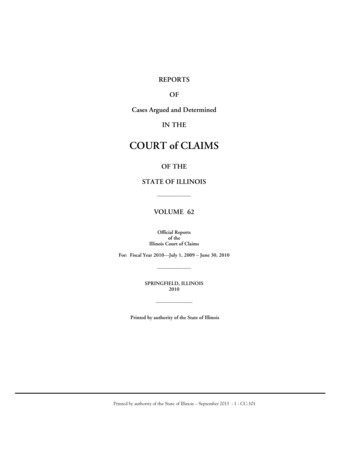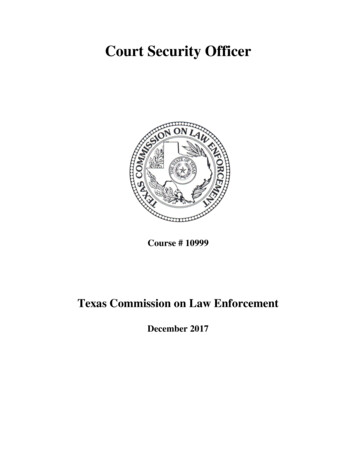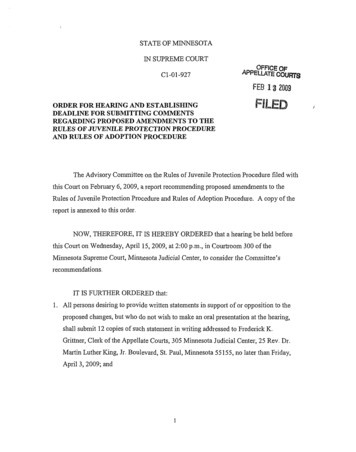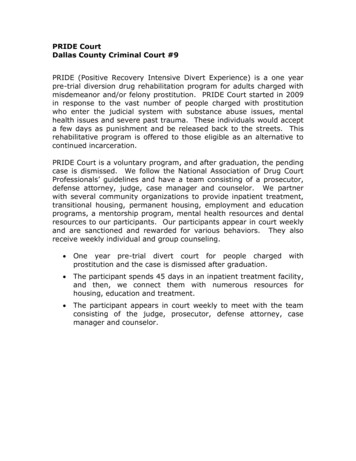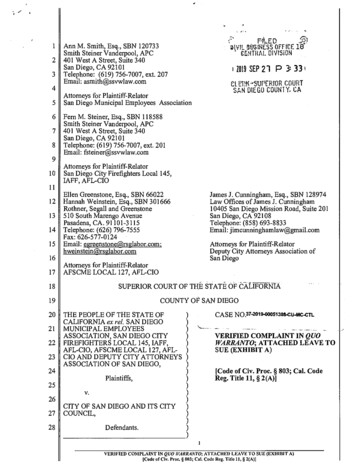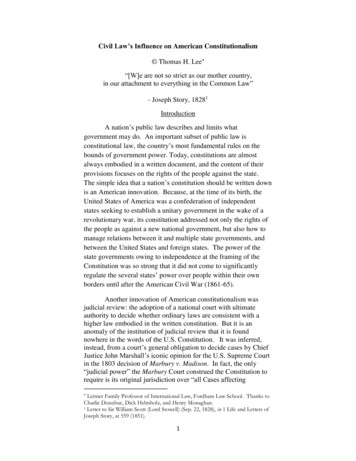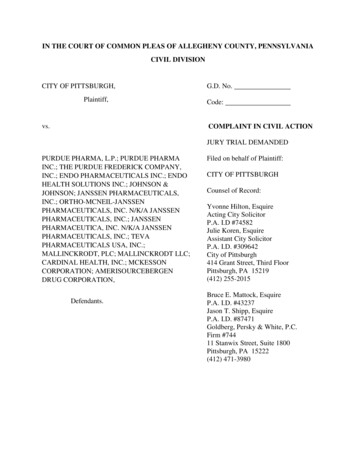
Transcription
IN THE COURT OF COMMON PLEAS OF ALLEGHENY COUNTY, PENNSYLVANIACIVIL DIVISIONCITY OF PITTSBURGH,Plaintiff,vs.G.D. No.Code:COMPLAINT IN CIVIL ACTIONJURY TRIAL DEMANDEDPURDUE PHARMA, L.P.; PURDUE PHARMAINC.; THE PURDUE FREDERICK COMPANY,INC.; ENDO PHARMACEUTICALS INC.; ENDOHEALTH SOLUTIONS INC.; JOHNSON &JOHNSON; JANSSEN PHARMACEUTICALS,INC.; ORTHO-MCNEIL-JANSSENPHARMACEUTICALS, INC. N/K/A JANSSENPHARMACEUTICALS, INC.; JANSSENPHARMACEUTICA, INC. N/K/A JANSSENPHARMACEUTICALS, INC.; TEVAPHARMACEUTICALS USA, INC.;MALLINCKRODT, PLC; MALLINCKRODT LLC;CARDINAL HEALTH, INC.; MCKESSONCORPORATION; AMERISOURCEBERGENDRUG CORPORATION,Defendants.Filed on behalf of Plaintiff:CITY OF PITTSBURGHCounsel of Record:Yvonne Hilton, EsquireActing City SolicitorP.A. I.D #74582Julie Koren, EsquireAssistant City SolicitorP.A. I.D. #309642City of Pittsburgh414 Grant Street, Third FloorPittsburgh, PA 15219(412) 255-2015Bruce E. Mattock, EsquireP.A. I.D. #43237Jason T. Shipp, EsquireP.A. I.D. #87471Goldberg, Persky & White, P.C.Firm #74411 Stanwix Street, Suite 1800Pittsburgh, PA 15222(412) 471-3980
IN THE COURT OF COMMON PLEAS OF ALLEGHENY COUNTY, PENNSYLVANIACIVIL DIVISIONCITY OF PITTSBURGHGD No.Plaintiff,Code:vs.JURY TRIAL DEMANDEDPURDUE PHARMA, L.P.; PURDUEPHARMA INC.; THE PURDUE FREDERICKCOMPANY, INC.; ENDOPHARMACEUTICALS INC.; ENDOHEALTH SOLUTIONS INC.; JOHNSON &JOHNSON; JANSSENPHARMACEUTICALS, INC.; ORTHOMCNEIL-JANSSEN PHARMACEUTICALS,INC. N/K/A JANSSENPHARMACEUTICALS, INC.; JANSSENPHARMACEUTICA, INC. N/K/A JANSSENPHARMACEUTICALS, INC.; TEVAPHARMACEUTICALS USA, INC.;MALLINCKRODT, PLC; MALLINCKRODTLLC; CARDINAL HEALTH, INC.;MCKESSON CORPORATION;AMERISOURCEBERGEN DRUGCORPORATION,Defendants.NOTICEYou have been sued in court. If you wish to defend against the claims set forth in the followingpages, you must take action within twenty (20) days after this complaint and notice are served, by entering awritten appearance personally or by attorney and filing in writing with the court your defenses or objectionsto the claims set forth against you. You are warned that if you fail to do so the case may proceed without anda judgment may be entered against you by the court without further notice for any money claimed in thecomplaint or for any claim or relief requested by the plaintiff. You may lose money or property or otherrights important to you.
IF YOU CANNOT AFFORD TO HIRE A LAWYER, THIS OFFICE MAY BE ABLE TO PROVIDE YOUWITH INFORMATION ON AGENCIES THAT MAY OFFER LEGAL SERVICES TO ELIGIBLEPERSONS AT A REDUCED FEE OR NO FEE.LAWYER REFERRAL SERVICEALLEGHENY COUNTY BAR ASSOCIATION400 KOPPERS BUILDING436 SEVENTH AVENUEPITTSBURGH, PA 15219TELEPHONE: (412) 261-0518
IN THE COURT OF COMMON PLEAS OF ALLEGHENY COUNTY, PENNSYLVANIACIVIL DIVISIONCITY OF PITTSBURGHGD No.Plaintiff,vs.JURY TRIAL DEMANDEDPURDUE PHARMA, L.P.; PURDUEPHARMA INC.; THE PURDUE FREDERICKCOMPANY, INC.; ENDOPHARMACEUTICALS INC.; ENDOHEALTH SOLUTIONS INC.; JOHNSON &JOHNSON; JANSSENPHARMACEUTICALS, INC.; ORTHOMCNEIL-JANSSEN PHARMACEUTICALS,INC. N/K/A JANSSENPHARMACEUTICALS, INC.; JANSSENPHARMACEUTICA, INC. N/K/A JANSSENPHARMACEUTICALS, INC.; TEVAPHARMACEUTICALS USA, INC.;MALLINCKRODT, PLC; MALLINCKRODTLLC; CARDINAL HEALTH, INC.;MCKESSON CORPORATION;AMERISOURCEBERGEN DRUGCORPORATION,Defendants.
COMPLAINT IN CIVIL ACTIONI.PRELIMINARY STATEMENT . 1II. JURISDICTION AND VENUE . 8III. PARTIES . 9A.Plaintiff . 9B.Defendants . 9IV. ALLEGATIONS COMMON TO ALL COUNTS . 14A.Manufacturing Defendants Falsely Trivialized, Mischaracterized, And Failed ToDisclose The Known, Serious Risks Of Addiction. . 151.Minimizing or mischaracterizing the risk of addiction. . 18B.Manufacturing Defendants Falsely Described Addiction as Pseudoaddiction andDangerously Encouraged Doctors to Respond by Prescribing More Opioids. . 251.Overstating the efficacy of screening tools. . 27C.Manufacturing Defendants Overstated the Benefits of Chronic Opioid Therapy WhileFailing to Disclose the Lack of Evidence Supporting Long-Term Use. . 301.Mischaracterizing the benefits and evidence for long-term use. . 302.Overstating opioids‘ effect on patients‘ function and quality of life. . 363.Omitting or mischaracterizing adverse effects of opioids. . 39Manufacturing Defendants Continued To Tell Doctors That Opioids Could Be Taken InD.Ever Higher Doses Without Disclosing Their Greater Risks. . 41E. Purdue Misleadingly Promoted Oxycontin As Supplying 12 Hours Of Pain Relief WhenPurdue Knew That, For Many Patients, It Did Not. . 43F.Purdue And Endo Overstated The Efficacy Of Abuse-Deterrent Opioid Formulations. . 451.Purdue‘s deceptive marketing of reformulated OxyContin and Hysingla ER. . 462.Endo‘s deceptive marketing of reformulated Opana ER. . 49G.Distributor Defendants Deliberately Disregarded Their Duties To Report SuspiciousOrders And To Exercise Reasonable Care. . 521. Distributor Defendants have a duty to report suspicious orders and to exercisereasonable care before shipping. . 532.Distributor Defendants understood the importance of their reporting obligations. . 553. Mallinckrodt failed its duty to maintain effective controls against diversion and reportsuspicious prescribing. 574. Manufacturer and distributor defendants have repeatedly violated their reportingrequirements. . 60
5. Distributor and manufacturing defendants worked together to sustain their markets andboost their products. . 646.Manufacturing Defendants and Distributors ignored red flags of abuse and diversion. 66H.The Distributor And Manufacturing Defendants Hid Their Lack Of Cooperation WithLaw Enforcement And Falsely Claimed To Be Actively Working To Prevent Diversion. . 69I.Purdue Made Deceptive Statements About Its Efforts To Address The Opioid Crisis. . 70J. By Increasing Opioid Prescriptions And Use, Defendants Collectively Fueled The OpioidEpidemic And Significantly Harmed The City And Its Citizens. . 71K.Defendants Fraudulently Concealed Their Misconduct. . 82V. CAUSES OF ACTION . 84VI. PRAYER FOR RELIEF . 104
I.1.PRELIMINARY STATEMENT―The opioid overdose epidemic is the worst public health crisis in Pennsylvania,and the nation, in almost a generation,‖ 1—the worst drug crisis in American history, accordingto Attorney General Jeff Sessions. Plaintiff the City of Pittsburgh, Pennsylvania (―the City‖), isbeing hit especially hard, with opioid overdose rates multiple times higher than in Pennsylvaniaas a whole, which already is higher than in the United States generally. Most alarmingly, opioidoverdose deaths in the City increased from 64 in 2010 to 231 in 2017, for an eight-year total of1,021 City residents who lost their lives to opioids.2.Unlike the crack cocaine and crystal methamphetamine epidemics that preceded it,this drug crisis began with a white-collar corporate business plan. It started with a decision byPurdue Pharma L.P., and its corporate family (collectively, ―Purdue‖), to promote opioidsdeceptively and illegally in order to significantly increase sales and generate billions of dollars inrevenue for Purdue and its private owners, the Sackler family. Unfortunately, Purdue‘s strategieswere quickly joined by Endo Pharmaceuticals Inc., Endo Health Solutions Inc., Johnson &Johnson, Janssen Pharmaceuticals, Inc. Orto-McNeil-Janssen Pharmaceuticals, Inc. N/K/AJanssen Pharmaceuticals, Inc., Janssen Pharmaceutica, Inc. N/K/A Janssen Pharmaceuticals, Inc.Teva Pharmaceuticals USA, Inc, and Mallinckrodt LLC (collectively with Purdue, ―theManufacturing Defendants‖), which all used misrepresentations regarding the risks and benefitsof opioids to enable the widespread prescribing of opioids for common, chronic pain conditions1Pennsylvania Opioid oard,CommonwealthofPennsylvania,
like low back pain, arthritis, and headaches.2 As a direct consequence, the rampant use, overuse,and abuse of opioids is devastating much of the country, including the City and its residents.3.Distributor Defendants McKesson Corporation d/b/a McKesson Drug Company,AmerisourceBergen Drug Corporation, and Cardinal Health, Inc. distribute opioid medications,including the medications listed above, to pharmacies, pain clinics and other dispensaries acrossthe country and, upon information and belief, in the City.4.Prescription opioids are narcotics regulated as controlled substances. They arederived from opium and possess properties similar to heroin. While opioids can work to dampenthe perception of pain, they also can create an addictive, euphoric high. At higher doses, theycan slow the user‘s breathing, causing potentially fatal respiratory depression. Most patientsreceiving more than a few weeks of opioid therapy will experience prolonged withdrawalsymptoms—including severe anxiety, nausea, headaches, tremors, delirium, and pain—if opioiduse is delayed or discontinued. When using opioids continuously, patients grow tolerant to theiranalgesic effects, requiring progressively higher doses and increasing the risks of withdrawal,addiction, and overdose.5.Because the medical community recognized these dangers, opioids wereoriginally used cautiously and sparingly, typically only for short-term acute pain—where briefuse limited the need for escalating doses and the risk of addiction—or for palliative (end-of-life)care. Consequently, the market for prescription opioids was sharply restricted.6.As Purdue developed OxyContin in the mid-1990s, it knew that to expand itsmarket and profits, it needed to change the perception of opioids to permit and encourage the use2Consistent with the commonly accepted medical usage, the term ―chronic pain‖ as used hereinrefers to non-cancer pain lasting three months or longer.2
of opioids as a first-line, long-term treatment for widespread chronic conditions like back pain,migraines, and arthritis.Purdue, along with the other Manufacturing Defendants, helpedcultivate a narrative that pain was undertreated and pain treatment should be a higher priority forhealth care providers. This paved the way for increased prescribing of opioids for first-linetreatment for chronic pain. Manufacturing Defendants‘ promotional efforts dovetailed with thisnarrative, as Manufacturing Defendants began to promote opioids generally, and their ownopioids in particular, as safe, effective, and appropriate for first-line, long-term use for routinepain conditions. As part of this strategy, Manufacturing Defendants misrepresented the risk ofaddiction for pain patients as modest, manageable, and outweighed by the benefits of opioid use.7.Between the 1990s and 2011, opioid prescriptions increased some 31% fromapproximately 1.6 million to approximately 2.2 million. According to a U.S. Department ofHealth and Human Services Fact Sheet, ―[i]n 2014, more than 240 million prescriptions werewritten for prescription opioids, which is more than enough to give every American adult theirown bottle of pills.‖8.Manufacturing Defendants‘ deceptive marketing efforts continued over the nextseveral years, eventually coming under investigation by a number of state and federal entities. In2007, Purdue and three of its executives pled guilty to federal criminal charges for deceptivelymarketing opioids and reached civil settlements with 26 states, including Pennsylvania. As laidout in its plea agreement, Purdue systematically misrepresented the risk of addiction, includingpromising that opioid addiction occurred in less than 1% of patients and that opioids were notaddictive when legitimately prescribed. However, rather than reforming its opioid marketing tocomply with the law, Purdue continued to mislead and obfuscate, as did the other Manufacturing3
Defendants. Similarly, in 2008, Cephalon pled guilty to a criminal violation of the Federal Food,Drug and Cosmetic Act and agreed to pay 425 million in civil fines.9.To this day, Manufacturing Defendants have failed to correct their earliermisrepresentations, and, in many respects, persist in the same types of misconduct. In the decadethat followed Purdue‘s guilty plea, the Manufacturing Defendants sustained a multi-billion dollarpain franchise through the same pattern of deceptive marketing. Specifically:Manufacturing Defendants informed and instructed doctors that patients receivingopioid prescriptions for pain generally would not become addicted, and thatdoctors could use screening tools to exclude patients who might.Manufacturing Defendants informed and instructed doctors that patients who didappear addicted were not; they were instead ―pseudoaddicted‖ and needed moreopioids.Manufacturing Defendants informed and instructed doctors that opioids relievedpain when used long-term, without any studies to support this claim and withoutdisclosing the lack of evidence that opioids were safe or effective long-term or theother risks from long-term use of opioids.Manufacturing Defendants informed and instructed doctors that opioids could betaken in higher and higher doses without disclosing the increased risk to patients.Purdue informed and instructed doctors that OxyContin provided 12 hours ofrelief when Purdue knew that, for many patients, it did not.Manufacturing Defendants promised that opioids would improve patients‘function and quality of life while trivializing or omitting the many adverse effectsof opioids that diminish patients‘ function and quality of life.10.Manufacturing Defendants knew that their representations regarding the risks andbenefits of opioids were not supported by, or were directly contrary to, the scientific evidence.Indeed, rather than helping patients, the explosion in opioid use has come at the expense of manychronic pain patients. In 2016, after reviewing the existing research, the U.S. Centers forDisease Control (―CDC‖) concluded that ―for the vast majority of [chronic pain] patients, theknown, serious, and too-often-fatal risks [of opioids] far outweigh the unproven and transient4
benefits.‖As the then CDC director concluded: ―We know of no other medication routinelyused for a nonfatal condition that kills patients so frequently.‖11.When faced with a rising tide of opioid addiction, overdose, and death – preciselythe risks that they denied for years – Purdue and Endo falsely promoted their abuse-deterrentopioids as preventing abuse and diversion and as ―safe.‖ Both Defendants knew, and evidenceshowed, that the ―abuse-deterrent‖ features of their opioids could be easily defeated, did nothingto decrease oral abuse, which is the most common means of abuse, and increased conversion toheroin. Purdue‘s and Endo‘s marketing was intended to, and did, reassure prescribers whobecame concerned about addiction that they not only could continue to prescribe opioids, but infact, needed to switch to their brands of abuse-deterrent opioids, thus preserving and expandingthese Defendants‘ market-share.12.In the same vein, Purdue also misrepresented its efforts to rein in the diversionand abuse of opioids, while privately failing to report suspicious prescribing. Upon informationand belief, all Manufacturing Defendants paid reimbursements known as ―chargebacks‖ towholesale distributors, and thereby obtained information about where their drugs were going asthey progressed from wholesalers to retailers and down the supply chain. Also upon informationand belief, Manufacturing Defendants also had access to detailed prescribing data, which theymonitored regularly to target and monitor their marketing efforts. Upon information and belief,Manufacturing Defendants failed to report suspicious orders or prescription patterns thatinformation available to them should have revealed.13.Manufacturing Defendants‘ scheme was resoundingly successful. ManufacturingDefendants‘ deceptive marketing caused prescribing not only of their opioids, but of opioids as aclass, to skyrocket. Opioids are now among the most prescribed classes of drugs. According to5
the CDC, opioid prescriptions, as measured by number of prescriptions and morphine milligramequivalent (―MME‖) per person, tripled from 1999 to 2015. In 2015, on an average day, morethan 650,000 opioid prescriptions were dispensed in the U.S. While previously a small minorityof opioid sales, today between 80% and 90% of opioids (measured by weight) are used forchronic pain. Approximately 20% of the population between the ages of 30 and 44, and nearly30% of the population over 45, have used opioids. Opioids are the most common treatment forchronic pain, and 20% of office visits now include the prescription of an opioid.14.While opioids have been diverted through illicit prescribing and sales, it is theregular, legitimate prescribing of opioids that created and fueled this crisis. A study of 254accidental opioid overdose deaths in Utah found that 92% had been receiving prescriptions fromhealth care providers for chronic pain.15.Once Manufacturing Defendants created a mass market for prescription opioids,Distributor Defendants flooded it. Distributor Defendants are responsible for delivering opioidsmade and marketed by the Manufacturing Defendants to pharmacies throughout the country.Distributor Defendants have a duty to report any suspicious orders of controlled substancesincluding orders of opioids that exceed reasonable volume or frequency, into the City. Yet, oninformation and belief, Distributor Defendants have supplied opioids to pharmacies within theCity in quantities that they knew, or should have known, exceed any legitimate market foropioids without reporting such suspicious orders to the Drug Enforcement Administration.16.As a direct result of the Manufacturing Defendants‘ dangerously false marketingand the Distributor Defendants‘ overzealous desire to fill even suspicious orders, the nation isnow swept up in what the CDC called a ―public health epidemic‖ and what President Trumpdeemed a ―public health emergency.‖ The increased volume of opioid prescribing correlates6
directly to skyrocketing addiction, overdose, and death; black markets for diverted prescriptionopioids; and a concomitant rise in heroin and fentanyl abuse by individuals who could no longerlegally acquire—or simply could not afford—prescription opioids.17.Every day, 91 people die across the country from an opioid-related overdose andover 1,000 patients are given emergency treatment for misusing them. Many others are sweptinto a cycle of addiction and abuse with which they will struggle their entire lives. As many as 1in 4 patients who receive prescription opioids long-term for chronic pain in primary care settingsstruggle with addiction. In 2014, almost 2 million Americans were addicted to prescriptionopioids and another 600,000 to heroin. From 1999 to 2015, more than 194,000 people died inthe U.S. from overdoses related to prescription opioids—more than the number of Americanswho died in the Vietnam War.18.The situation in Pennsylvania, including in the City, is equally catastrophic—andgetting worse. In the seven-year period between 2008-2014, there were 481 opiate-relatedoverdose deaths in the City. In just three years, the three-year period between 2015-2017, therewere 587 opioid overdose deaths.19.Defendants‘ conduct has violated, and continues to violate, the PennsylvaniaUnfair Trade Practices and Consumer Protection Law, 73 P.S. §§ 201-1 through 201-9.3.Additionally, Defendants‘ conduct constitutes a common law public nuisance, negligence, grossnegligence, and fraudulent misrepresentation, and resulted in their unjust enrichment.20.Accordingly, the City brings this action to hold Defendants accountable for theirconduct; and seeks disgorgement, restitution, abatement, damages, and any other injunctive andequitable relief within this Court‘s powers to redress and halt these unfair, deceptive, andunlawful practices.7
II.21.JURISDICTION AND VENUEThe venue for this claim is proper in the Court of Common Pleas of AlleghenyCounty, Fifth Judicial District of Pennsylvania, pursuant to 42 Pa. C.S.A. § 931(c) and Pa. R.Civ. P. 1006(b) & 2179(a). Venue as to each Defendant is proper in this court because each ofthe Defendants carries on regular business in Allegheny County, and because each cause ofaction herein arose in Allegheny County or Allegheny County was the location of a transactionor occurrence that took place out of which the cause of action arose.22.This Court has jurisdiction pursuant to Pa. Const. Art. V, § 4 and 42 Pa. C.S.A.§ 761; 42 Pa. C.S.A. § 931(a); 42 Pa. C.S.A. § 5322; and 16 P.S. § 202. Each Defendanttransacts business in the Commonwealth of Pennsylvania, contracts to supply goods in theCommonwealth of Pennsylvania, carries on a continuous and systematic part of their generalbusinesses within Pennsylvania, have transacted substantial business with Pennsylvania entitiesand residents, and have caused grave harm in Pennsylvania as a result.23.This action is not removable to federal court. Among other things, there is nodiversity jurisdiction. Defendants Teva USA, Cephalon, Endo Health Solutions Inc., EndoPharmaceuticals Inc., and AmerisourceBergen all have their principal places of business withinthe Commonwealth of Pennsylvania; and Defendants Janssen Pharmaceuticals, Inc. and OrtoMcNeil-Janssen Pharmaceuticals, Inc. are Pennsylvania corporations. In addition, the claimsalleged in the Complaint do not permit federal question jurisdiction to be exercised because thecase does not arise directly or indirectly under the Constitution, laws or treaties of the UnitedStates.8
III.PARTIESA.Plaintiff24.Plaintiff, the City of Pittsburgh, Pennsylvania, is a political subdivision of theCommonwealth of Pennsylvania. It is the county seat of Allegheny County. As of the 2017, thepopulation of the City was 305,704, making Pittsburgh the second-most populous city inPennsylvania. Plaintiff provides a wide range of services to its residents, including police, fireand emergency medical services (―EMS‖). Plaintiff also offers health insurance coverage for itsemployees and their dependents, and a workers‘ compensation program, both of which are selffunded. Accordingly, the City brings this action on its own behalf and as parens patriae in thepublic interest.B.Defendants25.Purdue Pharma, L.P. is a limited partnership organized under the laws ofDelaware, with its principal place of business in Stamford, Connecticut. Purdue Pharma, Inc. isa New York corporation with its principal place of business in Stamford, Connecticut. ThePurdue Frederick Company Inc. is a subsidiary of Pharmaceutical Research Associates, Inc., andis a Delaware corporation with its principal place of business in Stamford, Connecticut. TheseDefendants are collectively referred to herein as ―Purdue.‖ Purdue develops, manufactures,promotes, and sells opioids products such as MS Contin, Dilaudid, Dilaudid-HP, Butrans,Hysingla ER, and OxyContin.3 Purdue has conducted promotional activities in the City; and hassold its products to distributors that have distributed its products to pharmacists in the City.3OxyContin is Purdue‘s best-selling opioid. Since 2009, Purdue‘s annual sales of OxyContinhave fluctuated between 2 billion and 3 billion. Nationwide, OxyContin constitutes roughly25% of the entire market, by spending, for prescription opioids. Since its launch in 1996,OxyContin alone has generated 35 billion in sales for Purdue.9
Prescribers in the City have written prescriptions for Purdue‘s products, City residents have filledthose prescriptions at pharmacies in the City, and have used Purdue‘s products in the City.Purdue is, or should be, aware that its products have been distributed, prescribed to consumers,and used in the City.26.Teva Pharmaceuticals USA, Inc. (―Teva USA‖) is a Delaware corporation with itsprincipal place of business in North Wales, Pennsylvania. Teva USA acquired Cephalon inOctober 2011.4 Cephalon, Inc. (―Cephalon‖) is a Delaware corporation with its principal placeof business in Frazer, Pennsylvania. Teva USA and Cephalon work together closely to marketand sell Cephalon products. Teva USA also sells generic opioids, including generic opioidspreviously sold by Allergan plc, whose generics business was acquired by Teva USA‘s parentcompany, Teva Pharmaceutical Industries Ltd. Teva USA and Cephalon are collectively referredto herein as ―Teva.‖ Teva develops, manufactures, promotes, and sells opioids such as Actiq, afentanyl lollipop, and Fentora, a dissolving pill. Actiq and Fentora have been approved by theFood and Drug Administration (―FDA‖) only for the ―management of breakthrough cancer painin patients 16 years of age and older who are already receiving and who are tolerant to opioidtherapy for their underlying persistent cancer pain.‖ Teva has conducted promotional activitiesin the City and has sold its products to distributors that have distributed its products topharmacists in the City, Prescribers in the City have written prescriptions for Teva‘s products,and City residents have filled those prescriptions at pharmacies in the City and used Teva‘sproducts in the City. Teva is, or should be, aware that its products have been distributed,prescribed to consumers, and used in the City.4In 2008, Cephalon pled guilty to a criminal violation of the Federal Food, Drug and CosmeticAct and agreed to pay 425 million for its misleading promotion of Actiq and two other drugs.10
27.Janssen Pharmaceuticals, Inc. is a Pennsylvania corporation with its principalplace of business in Titusville, New Jersey, and is a wholly owned subsidiary of Johnson &Johnson (J&J), a New Jersey corporation with its principal place of business in New Brunswick,New Jersey.Ortho-McNeil-Janssen Pharmaceuticals, Inc., now known as JanssenPharmaceuticals, Inc., is a Pennsylvania corporation with its principal place of business inTitusville, New Jersey. Janssen Pharmaceutical Inc., now known as Janssen Pharmaceuticals,Inc., is a Pennsylvania corporation with its principal place of business in Titusville, New Jersey.J&J is the only company that owns more than 10% of Janssen Pharmaceuticals‘ stock, and itcorresponds with the FDA regarding Janssen‘s products. Upon information and belief, J&Jcontrols the sale and development of Janssen Pharmaceuticals‘ drugs and Janssen‘s profits inureto J&J‘s benefit. These Defendants are collectively referred to herein as ―Janssen.‖ Janssendevelops, manufactures, promotes, and sells drugs, including the opioid Duragesic. Before 2009,Duragesic accounted for at least 1 billion in annual sales. Until January 2015, Janssendeveloped, marketed, and sold the opioids Nucynta and Nucynta ER. Together, Nucynta andNucynta ER accounted for 172 million in sales in 2014. Janssen has conducted promotionalactivities in the City, and has sold its products to distributors that have distributed Janssen‘sproducts to pharmacists in the City. Prescribers in the City have written prescriptions forJanssen‘s products, and City residents have filled those prescriptions at pharmacies in the Cityand have used Janssen‘s products in the City. Janssen is, or should be, aware that its productshave been distributed, prescribed to consumers, and used in the City.28.Endo Health Solutions Inc. is a Delaware corporation with its principal place ofbusiness in Malvern, Pennsylvania. Endo Pharmaceuticals Inc. is a wholly-owned subsidiary ofEndo Health Solutions Inc. and is a Delaware corporation with its principal place of business in11
Malvern, Pennsylvania. These Defendants are collectively referred to herein as ―Endo.‖ Endodevelops, manufactures, promotes, and sells prescription drugs, including the opioidsOpana/Opana ER, Percodan, Percocet, and Zydone. Opioids made up roughly 403 million ofEndo‘s overall revenues of 3 billion in 2012. Opana ER yielded 1.15 billion in revenue from2010 to 2013, and it accounted for 10% of Endo‘s total revenue in 2012.Endo alsomanufactures and sells generic opioids such as oxycodone, oxymorphone, hydromorphone, andhydrocodone products, by itself and through its subsidiary, Qualitest Pharmaceuticals, Inc. OnJuly 6, 2017, in response to an FD
pages, you must take action within twenty (20) days after this complaint and notice are served, by entering a . a judgment may be entered against you by the court without further notice for any money claimed in the complaint or for any claim or relief requested by the plaintiff. You may lose money or



